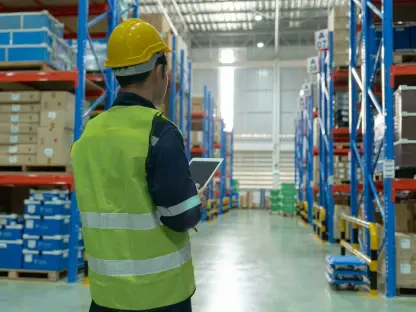The landscape of last-mile delivery is rapidly transforming, driven by rising consumer expectations and advances in technology. This dynamic segment of logistics requires companies to adapt strategically to stay competitive, efficient, and effective in meeting customer demands. From AI technology and data-driven decisions to outsourcing and sustainability, the shifts in last-mile delivery are becoming critical areas for businesses aiming to excel in today’s fast-paced market.
The Changing Face of Consumer Expectations
Speed and Convenience as Key Drivers
In the modern era, consumers demand swift and convenient delivery solutions, pushing companies to enhance their logistical prowess. The willingness of customers to pay extra for expedited services, especially during peak seasons, highlights the necessity for businesses to offer same-day or specific time-slot deliveries. However, the shift isn’t just about speed; it’s about enhancing the entire post-purchase experience, ensuring that deliveries are efficient, precise, and seamlessly integrated into consumers’ lifestyles.
As part of this transformation, logistics companies are investing in advanced technologies and streamlined processes. Innovations like real-time tracking, route optimization, and automated systems are pivotal in meeting heightened consumer expectations. These technological upgrades enable faster deliveries and contribute to a more transparent and predictable delivery process. Furthermore, the ability to offer multiple delivery options—ranging from same-day delivery to scheduled time slots—empowers consumers, giving them control over their purchase journey. Such enhancements in delivery capabilities not only meet rising expectations but also foster customer loyalty and repeat business.
Impact on Post-Purchase Satisfaction
Consumers now expect a seamless post-purchase journey, requiring companies to provide fast deliveries, hassle-free returns, and transparent, real-time communication throughout the process. This shift places customer satisfaction and sustainability at the forefront of logistics strategies, making the holistic delivery experience a significant competitive differentiator in a crowded market. Businesses that fail to adapt and meet these evolving demands risk losing customer loyalty and market share.
To maximize post-purchase satisfaction, companies are continuously improving their customer service and communication channels. Technologies like automated customer support and chatbots offer instant responses and resolutions, reducing wait times and enhancing the overall customer experience. Moreover, integrating feedback systems enables businesses to gather insights and make necessary adjustments quickly. By adopting a customer-centric approach, logistics firms can build strong relationships and ensure repeat business. In an era where the post-purchase experience is as critical as the purchase itself, focusing on transparency, communication, and customer support becomes indispensable.
Technological Advancements Powered by AI
AI in Demand Forecasting
AI and emerging technologies are revolutionizing the last mile by significantly improving demand forecasting accuracy. Companies leveraging AI-driven analytics can predict customer needs more accurately, allowing them to proactively scale operations and manage inventory efficiently. According to industry reports, these technologies can boost delivery efficiency by up to 20%, underscoring their importance in modern logistics. The ability to accurately forecast demand helps prevent stockouts, reduces excess inventory, and ensures timely deliveries, ultimately enhancing customer satisfaction and loyalty.
AI-driven demand forecasting relies on big data analytics to identify trends and patterns from vast datasets, enabling precise predictions and timely responses. Machine learning algorithms continuously refine these predictions, adapting to changing market dynamics and consumer behavior. This capability allows companies to adjust their supply chains dynamically, ensuring that they can meet demand without overextending resources. The adoption of AI in demand forecasting not only enhances operational efficiency but also supports strategic decision-making, enabling businesses to stay ahead of the competition and respond to market shifts with agility and precision.
Enhancing Operational Efficiency
Beyond forecasting, AI enables robust data analytics, identifying patterns and opportunities for growth that facilitate more informed decision-making. This deep analysis allows logistics companies to adapt their strategies in real-time, ensuring that they remain responsive to changing market conditions and consumer expectations. Through AI, firms can optimize delivery routes, manage workloads, and enhance overall operational efficiency, resulting in faster and more reliable deliveries and better utilization of resources.
AI-powered systems can dynamically assign tasks based on real-time data, optimizing route planning to minimize delivery times and fuel usage. These systems can also anticipate potential disruptions, such as traffic congestion or weather changes, and adjust routes accordingly to ensure timely deliveries. Additionally, AI supports predictive maintenance for delivery vehicles, reducing downtime and maintaining fleet efficiency. By integrating AI into their operations, logistics companies can achieve greater levels of precision, reduce operational costs, and enhance customer satisfaction, ultimately driving business growth in a competitive market.
Outsourcing for Strategic Flexibility
Evolution of Outsourcing Strategies
Outsourcing is no longer merely a cost-cutting measure; it has become a strategic imperative that allows for scalability and flexibility in last-mile delivery operations. As labor and fuel costs rise, companies are increasingly turning to third-party providers to manage delivery challenges, ensuring that they can maintain high delivery speeds and quality service even during demand spikes. This approach supports businesses in navigating fluctuating operational demands without compromising efficiency or customer satisfaction.
Incorporating external partners into logistics frameworks enables companies to leverage specialized expertise and technologies that may not be feasible to develop in-house. Third-party logistics providers often have established networks, advanced technology platforms, and industry experience that contribute to streamlined operations and enhanced service quality. This collaboration allows businesses to focus on their core competencies while benefiting from the agility and adaptability that outsourcing offers. As market conditions continue to evolve, strategic outsourcing becomes essential for maintaining competitiveness and meeting consumer expectations in the dynamic last-mile delivery landscape.
Impact on Operational Costs
Utilizing external partners enables companies to streamline operations and reduce internal pressures, addressing cost structures dynamically and helping firms navigate fluctuating expenses while meeting customer demands. Effective outsourcing can significantly reduce delivery costs, contributing to better financial health and more competitive offerings in the marketplace. By outsourcing certain logistical functions, companies can achieve cost efficiency, improve service quality, and focus on scaling their core operations.
In addition to cost savings, outsourcing offers benefits in terms of resource allocation and risk management. External partners can absorb some of the operational risks associated with fluctuating demand and capacity constraints, providing a buffer that helps companies maintain consistency in their delivery services. Furthermore, outsourcing can facilitate access to advanced technology and infrastructure without significant capital investment, accelerating innovation and operational improvements. By strategically leveraging outsourcing, businesses can enhance their last-mile delivery capabilities, ensuring they remain agile and responsive to market demands.
Emphasis on Performance Metrics
Shift Towards Performance-Based Evaluation
To improve last-mile delivery, companies are adopting performance-based metrics that extend beyond traditional customer satisfaction indicators. Key metrics such as on-time delivery rates and cost per delivery have become central to measuring success, providing a more comprehensive view of operational efficiency. For instance, on-time delivery rates surged to 62% in 2023, reflecting a heightened focus on fulfilling commitments reliably and meeting customer expectations. This shift towards performance metrics underscores the need for a strategic approach to managing last-mile delivery operations.
Performance-based evaluation enables companies to identify areas for improvement, allocate resources more effectively, and implement targeted strategies to enhance service quality. By monitoring key indicators, logistics firms can pinpoint inefficiencies, measure the impact of changes, and continuously refine their processes. This data-driven approach supports better decision-making and accountability, fostering a culture of continuous improvement and operational excellence. As companies strive to meet evolving consumer demands, the emphasis on performance metrics becomes crucial for maintaining competitiveness and delivering exceptional service.
Importance of Cost Efficiency
Monitoring and optimizing cost per delivery enable companies to maintain profitability while enhancing service quality, ensuring that they can meet customer demands efficiently and sustainably. By focusing on performance metrics, logistics firms can identify inefficiencies and implement strategic changes to improve their overall delivery operations. This shift represents a more strategic approach to managing logistics, balancing cost considerations with the need for high-quality service.
Cost efficiency is achieved through a combination of technological integration, process optimization, and strategic partnerships. Advanced analytics and AI-driven tools can provide insights into cost drivers, enabling companies to implement targeted solutions that reduce expenses while maintaining service standards. Strategies such as route optimization, load consolidation, and automated workflows contribute to lower operational costs without compromising delivery performance. By prioritizing cost efficiency, logistics companies can enhance their competitiveness, offer more attractive pricing to customers, and invest in further innovations to drive growth and sustainability in the last-mile delivery sector.
Regional Differences in Delivery Expectations
Customizing Strategies by Region
Regional variations play a significant role in last-mile delivery strategies, requiring companies to tailor their logistics approaches to cater to diverse consumer expectations and market conditions. Consumers in the APAC and Americas regions, for example, show a strong preference for same-day and next-day deliveries, emphasizing the importance of localized strategies and greater operational agility. To meet these regional demands, companies must develop customized plans that consider local infrastructure, consumer behavior, and regulatory requirements.
Adapting to regional differences involves more than just adjusting delivery timelines; it demands a comprehensive understanding of the unique challenges and opportunities within each market. Companies need to assess factors such as urban density, transportation infrastructure, and local regulations to design effective delivery networks that maximize coverage and efficiency. By leveraging regional expertise and building flexible logistics frameworks, businesses can respond swiftly to changing conditions and provide consistent, high-quality service. Tailoring strategies to specific markets enhances overall customer satisfaction and drives competitive advantage in diverse regions.
Addressing Regional Challenges
Understanding specific regional challenges, such as infrastructure limitations or regulatory requirements, is crucial for effective strategy implementation in last-mile delivery. By customizing delivery operations to regional conditions, companies can enhance their service quality and customer satisfaction, ultimately achieving a competitive advantage in various markets. Addressing these challenges requires a proactive approach, leveraging local knowledge and partnerships to navigate complexities and optimize delivery operations.
For example, in regions with inadequate transportation infrastructure, companies might invest in alternative delivery methods such as bike couriers or drones to ensure timely deliveries. In areas with stringent regulatory requirements, businesses must stay informed and compliant, adapting their operations to meet local standards. Collaborating with local logistics providers can also provide valuable insights and support, enabling companies to overcome obstacles and deliver exceptional service. By addressing regional challenges effectively, logistics firms can maintain resilience and agility, ensuring that they meet customer expectations consistently across different markets.
Data-Driven Decision Making
Leveraging Analytics Tools
Data analytics tools are at the heart of modern logistics strategies, enabling companies to gather, interpret, and act on vast amounts of data to drive continuous improvement in last-mile delivery operations. Leveraging analytics capabilities allows for better demand forecasting, route optimization, and identification of growth opportunities, ultimately enhancing operational efficiency and customer satisfaction. Companies that effectively utilize data-driven decision-making can stay ahead of market trends, optimize resources, and deliver superior service.
Advanced analytics platforms integrate various data sources, providing a holistic view of logistics operations and customer interactions. This comprehensive perspective allows businesses to identify patterns, anticipate challenges, and make informed decisions that align with strategic goals. Predictive analytics, for instance, can forecast demand fluctuations, enabling proactive inventory management and capacity planning. By continuously refining their analytics capabilities, logistics companies can improve accuracy, responsiveness, and overall performance. The power of data-driven decision-making lies in its ability to transform raw information into actionable insights, driving efficiency and innovation in last-mile delivery.
Importance of Real-Time Communication
Transparent, real-time communication is essential for maintaining customer loyalty in last-mile delivery, providing real-time delivery updates and full supply chain visibility to significantly reduce customer inquiries and bolster satisfaction. Companies that invest in technologies for real-time tracking are better positioned to build trust and retain customers, as transparency and communication become key differentiators in the competitive logistics landscape.
Real-time tracking systems offer customers the ability to monitor their deliveries at every stage, from dispatch to final arrival. This transparency reduces uncertainty and enhances the overall delivery experience, fostering a sense of reliability and trust. Additionally, real-time communication allows companies to address issues proactively, such as delivery delays or address discrepancies, ensuring prompt resolutions and maintaining customer confidence. By prioritizing real-time communication, logistics firms can enhance their service quality, reduce operational disruptions, and build long-term customer relationships. In an era where consumers expect instant information and seamless experiences, real-time communication is a critical component of successful last-mile delivery.
Sustainability as a Competitive Differentiator
Eco-Friendly Delivery Practices
Sustainability is increasingly becoming a key differentiator in last-mile delivery, with consumers and businesses alike emphasizing the need for eco-friendly practices. Companies are responding by integrating sustainable initiatives into their operations, utilizing electric vehicle fleets, carbon-neutral facilities, and drones for deliveries to reduce environmental impact. These efforts are not only environmentally beneficial but also resonate with socially conscious consumers, enhancing brand reputation and customer loyalty.
Adopting eco-friendly delivery practices involves significant investment in green technologies and infrastructure, but the long-term benefits outweigh the initial costs. Electric vehicle fleets reduce emissions and operational costs associated with fuel, while carbon-neutral facilities support sustainable operations and compliance with regulations. Drones offer a sustainable alternative for certain deliveries, reducing road congestion and lowering carbon footprints. By championing sustainability, companies demonstrate their commitment to environmental stewardship, attracting eco-conscious customers and differentiating themselves in a crowded market. Sustainable practices are no longer optional but essential for businesses looking to thrive in the evolving last-mile delivery landscape.
Long-Term Benefits of Sustainable Practices
The landscape of last-mile delivery is evolving at an unprecedented pace, fueled by rising consumer expectations and significant technological advances. This crucial segment of the logistics industry requires companies to strategically adapt in order to remain competitive, efficient, and responsive to customer needs. In today’s fast-paced market, businesses are turning to a variety of strategies to excel in last-mile delivery. AI technology plays a pivotal role by enabling data-driven decisions that streamline operations. Companies are also increasingly outsourcing delivery services to enhance efficiency and scalability. Sustainability is another key focus, as environmentally conscious consumers demand greener delivery options. The integration of electric vehicles, drones, and even bike couriers signifies a shift towards reducing the carbon footprint associated with last-mile delivery. These transformative changes are reshaping how goods reach consumers’ doorsteps, underscoring the need for businesses to stay agile and innovative in their approaches.









